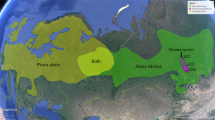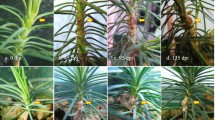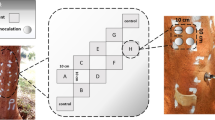Abstract
In order to confirm the pathogenicity ofCistella japonica, inoculation experiments were conducted onto several coniferous trees. Resinous lesions similar to those of the resinous stem canker developed by the inoculation withCi. japonica only onChamaecyparis obtusa. Chamaecyparis trees were heavily affected when inoculated with the fungus in November, but slightly in May and August. Resin flows occurred when inocula ofCi. japonica were put into the holes made on stem barks and on pruning scars. Isolates ofCi. japonica varied greatly in the pathogenicity. On the lesions caused by the fungus, resinous and necrotic areas expanded in fusiform or oblong shape, and resin cysts were formed in inner barks. Beneath some necrotic inner barks, sapwood was suppressed in growth for the damages in cambial cells and stained.Ci. japonica was reisolated from the inoculated lesion tissues, though isolation frequency of the fungus became lower in some lesions two or more years after the inoculation. The results of these inoculations proved thatCi. japonica was the causal agent of the resinous stem canker ofCh. obtusa.
Similar content being viewed by others
Literature cited
Kitajima, K. (1927) New diseases of forest trees observed recently in different districts of Japan. J. Jpn. For. Soc 9: 34–42. (in Japanese) The titles are tentative translation from Japanese titles by the author of this paper.
Kobayashi, T. (1986) Fungal diseases and their causal fungi (3).In Introduction to forest pathology. Kobayashiet al. (eds.), Yokendo, Tokyo, 220–241. (in Japanese) The titles are tentative translation from Japanese titles by the author of this paper.
Kobayashi, T., Hayashi, H., Kubono, T., Tabata, M., and Ito, S. (1990) Etiological and pathological studies on the resinous stem canker of Hinoki cypress,Chamaecyparis obtusa Sieb. et Zucc. I. Detection, identification and pathogenicity of the causal fungus. Bull. For. For. Prod. Res. Inst. 357: 51–93. (in Japanese with English summary)
Koiwa, T., Kusunoki, M., Miyashita, S., Hasegawa, E., and Ogura, T. (1996) Correlation between resinous disease of hinoki (Chamaecyparis obtusa) and adjoining sugi (Cryptomeria japonica) forests with special reference to the influence of hinoki bark moth on the disease occurrence. J. Jpn. For. Soc. 78: 280–284. (in Japanese with English summary)
Kubayashi, T. and Yamashita, R. (1993) Resinous disease of Hinoki (Chamaecyparis obtusa) in Nagasaki Prefecture. Bull. Nagasaki Agric. Forest Exp. Stn. (Sect. of Forestry) 24: 1–13. (in Japanese)
Kubayashi, T. and Haizuka, T. (1995) Damage occurrence of the resinous stem canker inChamaecyparis obtusa, and its causal factors in Kyushu district. Forest Pests 44: 23–29. (in Japanese) The titles are tentative translation from Japanese titles by the author of this paper.
Nagashima, M. (1995) Damage occurrence of the resinous stem canker inChamaecyparis obtusa and its causal factors in Kanto and Chubu districts Forest Pests 44: 53–61. (in Japanese) The titles are tentative translation from Japanese titles by the author of this paper.
Sakuyama, T. (1991) Fungi isolated from resinous lesions of Hinoki (Chamaecyparis obtusa) and its pathogenicity (II). Symptomatic changes for six years after inoculation and traumatic resin canals. Proc. Jpn. For. Soc. 102:319–320. (in Japanese)
Sakuyama, T., Sotodate, S., and Kobayashi, M. (1987) Fungi isolated from resinous lesions of Hinoki (Chamaecyparis obtusa) and its pathogenicity. Proc. Jpn. For. Soc. 98: 519–520. (in Japanese)
Sanui, T. and Hattori, H. (1989) Observation of the resin pool found in the inner bark ofChamaecyparis obtusa. Proc Jpn. For. Soc. 100: 625–626 (in Japanese)
Shoji, T. (1990) Distribution ofCryptosporiopsis abietina on some tree species in the Kanto district. Proc. Jpn. For. Soc. 101: 571–572. (in Japanese)
Suto, Y. (1985) A new collection of a resinicolous discomycete,Sarea resinae, and some physiological characteristics of the fungus. Trans. mycol. Soc. Jpn. 26: 331–341.
Suto, Y. (1987) Resinous stem canker syndrome inChamaecyparis obtusa, exceptMonochaetia stem canker. Disease development and the causal agent. Forest Pest 36: 117–122. (in Japanese) The titles are tentative translation from Japanese titles by the author of this paper.
Suto, Y. (1991)Cistella sp. a fungus isolated from lesions of resinous stem canker inChamaecyparis obtusa, and its pathogenicity. Proc. Jpn. For. Soc. 102: 317–318. (in Japanese)
Suto, Y. (1992a) A new species ofCistella (Discomycetes) inhabiting bark ofChamaecyparis obtusa andCryptomeria japonica, and its cultural characters. Trans. Mycol. Soc. Jpn. 33: 433–442.
Suto, Y. (1992b) Inoculation tests withCryptosporiopsis abietina andSarea resinae toChamaecyparis obtusa andCryptomeria japonica. Proc. Jpn. For. Soc. 103: 559–560. (in Japanese)
Suto, Y. (1995a) Isolation of fungi from the lesions of the resinous stem canker and the sound stems inChamaecyparis obtusa. Bull. Shimane Pref. For. Res. Cent 46: 1–9. (in Japanese with English summary)
Suto, Y. (1995b) Researches on the damage and control of the resinous stem canker inChamaecyparis obtusa in Kansai district. Forest Pests 44: 46–53, 1995. (in Japanese)
Suto, Y. and Kanamori, H. (1989) Damage of resinous canker of Hinoki (chamaecyparis obtusa) in Shimane Prefecture. Proc. Jpn. For. Soc. 100: 623–624. (in Japanese)
Suto, Y. and Kanamori, H. (1990) Studies of damage and causal agent of resinous stem canker ofChamaecyparis obtusa in Shimane Prefecture. Japan. Bull. Shimane Pref. For. Res. Cent. 41: 31–50. (in Japanese with English summary)
Suto, Y., Kanamori, H., and Inoue, J. (1994) Researches on the resinous stem canker ofChamaecyparis obtusa in Shimane Prefecture. Bull. Shimane Pref. For. Res. Cent. 45: 17–25. (in Japanese with English summary)
Suzuki, K., Fukuda, K., Kaji, M., and Kamitani, T. (1988) Mechanisms on the incidence of “Rooshi” pitch canker ofChamaecyparis obtusa andThujopsis dolabrata var.Hondai. Bull. Tokyo Univ. For. 80: 1–23. (in Japanese with English summary)
Tsuchiya, D. and Zinno, Y. (1993) Researches on the damage of resinous stem canker ofChamaecyparis obtusa in Tokyo Metropolitan (I). Analysis of the damage and isolation of fungi from resinous parts. Proc. Jpn. For. Soc. 104: 629–630. (in Japanese)
Yanagita, N. and Koiwa, T. (1995) Damage occurrence of the resinous stem canker inChamaecyparis obtusa and its causal factors in Tohoku district. Forest Pests 44: 30–37. (in Japanese) The titles are tentative translation from Japanese titles by the author of this paper.
Yokozawa, Y., Kaneko, S., and Zinno, Y. (1986) Inoculation tests with the fungi isolated from the lesions of the resinous stem canker inChamaecyparis obtusa (I) Results till two, years after the inoculation. Proc. Jpn. For. Soc. Tohoku Branch 38: 207–208. (in Japanese). The titles are tentative translation from Japanese titles by the author of this paper.
Yokozawa, Y., Kaneko, S., and Kubono, T. (1989) Inoculation tests with the fungi isolated from the lesions of the resinous stem canker inChamaecyparis obtusa (II). Results till five years after the inoculation. Proc. Jpn. For. Soc. Tohoku Branch 41: 199–201. (in Japanese) The titles are tentative translation from Japanese titles by the author of this paper.
Author information
Authors and Affiliations
About this article
Cite this article
Suto, Y. Etiology of the resinous stem canker ofChamaecyparis obtusa: Cistella japonica as the causal agent. J. For. Res. 2, 59–65 (1997). https://doi.org/10.1007/BF02348264
Accepted:
Issue Date:
DOI: https://doi.org/10.1007/BF02348264




